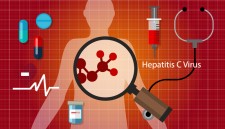
Hepatitis C Virus via shutterstock
If you're affected by the Hepatitis C virus, 2015 has had to have been a year full of promise and hope. First, there was FDA's approval of the treatment (Viekira Pax), and recently researchers at University of California, Irvine have unearthed diagnostic gold with their latest screening process.
Researchers were able to create a one-step method of detecting and confirming the HCV antigen, using urine. This new antigen test system is simpler and more cost effective than the current two-step method, which involves the identification of antibodies to the virus within a blood sample, followed by a RNA polymerase chain reaction (PCR) test for confirmation and to distinguish between active infection versus a prior infection. PCR involves the use of molecular biology technology to create thousands of copies of a DNA sequence.
Cheap and accessible are the two advantages this new test holds over its predecessor. Besides eliminating the need for blood samples -- which many phlebotomists and clinicians will love, as it decreases the chances of needlestick injuries and subsequent exposure of healthcare workers to the virus -- the new antigen test is expected to cost less than the $200+ price of the current test.
The price tag attached to acquisition and maintenance of the PCR machine itself is sometimes the cause of its unavailability by some healthcare providers, particularly in the developing world where healthcare already has many issues resulting from limited resources. Perhaps that's where this test can make the most impact -- the developing world.
The ease of administering the test is expected to help the screening process immensely. With acute HCV infection being largely asymptomatic, many don't have an overt reason to suspect they have been infected, to seek screening. Furthermore, many can live with the virus for decades before signs surface.
CDC figures indicate that nearly 2.7 million people in the United States suffered from chronic HCV infection, and even that might be an underestimate. By comparison, the WHO estimates anywhere between two and four million in the U.S. are chronically impacted by the HCV.


